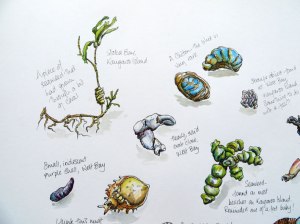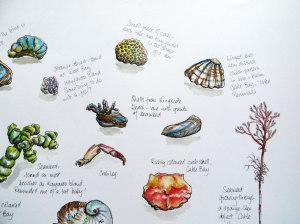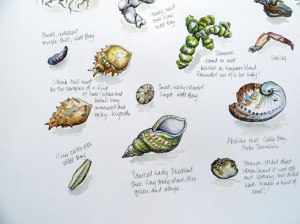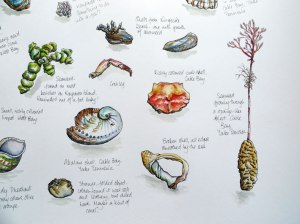The journey is now complete – the items collected and sketched from beaches and river banks along Yorke Peninsula and Kangaroo Island in South Australia have been put together in one large drawing. As with part 1 (click here to see it) doing the drawings took me back to our journey. Yorke Peninsula is flat and agricultural, good crops everywhere we went. The place we stayed longest was Cable Bay, in the Innes National Park at the very tip of the peninsula. The beach was long and clean, with plenty of interesting rock forms. Kangaroo Island was different again, each beach having its own character, but so many had interesting and unusual shells and rocks. There were many other points of interest there, the seals and sea lions, strange and inexplicable bits of flotsam and jetsam, pieces of rope and wood, but something that struck me was the abundance of rich colour in the objects I found. Doing these drawings has taken me on an enjoyable virtual journey.
Pen and ink and watercolour on hot pressed Magnani Corona paper, 70 x 50 cm





What a lovely way to store memories.
LikeLike
Thank you Monica, it really does!
LikeLike
You know what these remind me of? The charts in St James Park (London) by the lake identifying species of birds which live there. All the birds are drawn (as opposed to photographed) and there is a bit of writing beside each one.
Tell me, do you plan in advance where each object will go or do you kind of draw your way round your piece of paper – deciding after you have drawn one thing where the next thing will go? The two kind of branches bookending the drawing would make me think that it is all planned out before you make the first mark. At the same time, the objects look random – just like you’d find them in nature.
The drawings are a marriage of art and science!
LikeLike
Yes, I know the kind of charts you mean – they are often in places where there is a lot of wildlife. I did plan the composition quite carefully, I printed out scans of pages from my sketchbook, cut out the images I wanted then arranged them on the sheet. With the first one that was the final composition, but this one felt a bit empty once I had sketched it up, so I found more objects to fill the gaps. I like the thought they are a marriage of art and science!
LikeLike
Very good. Thanks for telling us your process, Anna. I’m pretty sure that if I was working on something similar I would also want to plan it out like you have.
LikeLike
In the past I have let artworks dictate how they happen in an organic way, but with this I really felt the composition needed to be clear from the beginning. With the first one I thought about how the forms worked together but didn’t take colour into account, as I was working from black and white printouts of the original sketches, so was a bit surprised by some of the relationships I ended up with. For this one I thought about that more, and I knew that there would be more variety of colour, but still found I needed to go back and intensify some colour. Also, with the first one I got around some of the colour issue by not being totally faithful to my original drawings, which was ok because I didn’t want them to be a carbon copy anyway.
LikeLike
I love these paintings so much. Thank you for sharing how you plan out your composition. This level of detail (designing your space) makes the presentation all that more delightful to look at. It is marriage between art and science for sure!
Would you ever consider sharing images of your process? I’m enjoying this series so much.
LikeLike
Thank you so much! When you say images of the process, do you mean the progression of the drawings? I do have photos of the initial drawings, then the drawings with colour added, before the wording was put on. I didn’t think to take photos of the planning stages, an awful lot goes on in my head! But I could describe how I developed the idea and the final composition if that would be of any interest!
LikeLike
Yes, that’s exactly what I’m thinking. I know exactly what you mean about a fair amount takes place in your head. I think that’s part of the creative process, “chewing on an idea”. But I would love to see your sketches, where you start and progress on paper.
LikeLike
Ok, will see what I can do! Thanks for being so interested and encouraging!
LikeLike
Gorgeous again Anna, they have turned out so well, I have always been a fan of the found object. These little things evoke such wonderful memories. So much nicer to draw them and leave them where they are. I think they would also look nice as a series of individual drawings or maybe a book. I would also like to see the work in progress pictures. I love the looking over the shoulder of the artist feel they give. Karen
LikeLike
Yes, the serendipity of the found object gives a different quality to those things that one has actively sought out. I must admit I do bring a few things home, the odd shell or interesting seed pod, with the intention of using them again, but other things, such as seaweed are only beautiful temporarily anyway. A concertina book of the drawings is at the back of my mind, but it may need to be new objects, or from other sketchbooks (I do have quite a few!) I will do a post about the process in a few days time. Thanks for your comments Karen, always appreciate them!
LikeLike
Very good work documenting natural history, and memories.
LikeLike
Thank you Bente!
LikeLike
Part 2 is every bit as excellent as Part 1! Brilliant work!
LikeLike
Thank you so much Elena!
LikeLike
More to adore!!! And I do.
😀
xo,
Kathryn
LikeLike
You are very kind! Thank you.
LikeLike
Each is a little treasure Anna . I love the Lady Pheasant shell and your description of the seaweed reminding you of a fat baby 😉
LikeLike
Thanks Poppy! The Lady Pheasant shell was quite unlike any I had seen before, such rich colours especially when it was wet. The seaweed really was like that, it was quite unsettling to walk on!
LikeLike
*smiling .. yes … and sometimes seaweed pops too underfoot doesn’t it … EEK
I shan’t be able to look at the only photo of me as a baby now Anna without thinking *seaweed 😀
I think a *bonny baby was the term used in those days
LikeLike
But I bet you weren’t green!!; D
LikeLike